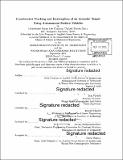Coordinated tracking and interception of an acoustic target using autonomous surface vehicles
Author(s)
Conway, Ryan Lee.
Download1142187058-MIT.pdf (6.723Mb)
Other Contributors
Joint Program in Applied Ocean Science and Engineering.
Massachusetts Institute of Technology. Department of Mechanical Engineering.
Woods Hole Oceanographic Institution.
Advisor
Erin Fischell.
Terms of use
Metadata
Show full item recordAbstract
In today's highly advanced society, more industries are beginning to turn to autonomous vehicles to reduce costs and improve safety. One industry in particular is the defense industry. By using unmanned and autonomous vehicles, the military and intelligence communities are able to complete missions without putting personnel in harm's way. A particularly important area of research is in the use of marine vehicles to autonomously and adaptively track a target of interest in situ by passive sonar only. Environmental factors play a large role in how sound propagates in the ocean, and so the vehicle must be able to adapt based on its surrounding environment to optimize acoustic track on a contact. This thesis examines the use of autonomous surface vehicles (ASVs) to not only autonomously detect and localize a contact of interest, but also to conduct follow-on long-term tracking and interception of the target, by using anticipated environmental conditions to motivate its decisions regarding optimum tracking range and speed. This thesis contributes a simulated and theoretical approach to using an ASV to maximize signal-to-noise ratio (SNR) while tracking a contact autonomously. Additionally, this thesis demonstrates a theoretical approach to using information from a collaborating autonomous vehicle to assist in autonomously intercepting a target.
Description
Thesis: S.M., Joint Program in Applied Ocean Science and Engineering (Massachusetts Institute of Technology, Department of Mechanical Engineering; and the Woods Hole Oceanographic Institution), 2019 Cataloged from PDF version of thesis. Includes bibliographical references (pages 67-69).
Date issued
2019Department
Joint Program in Applied Ocean Science and Engineering; Massachusetts Institute of Technology. Department of Mechanical Engineering; Woods Hole Oceanographic InstitutionPublisher
Massachusetts Institute of Technology
Keywords
Joint Program in Applied Ocean Science and Engineering., Mechanical Engineering., Woods Hole Oceanographic Institution.